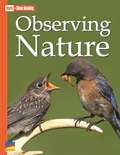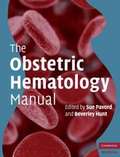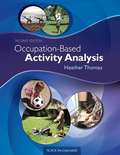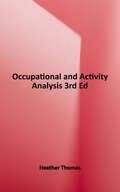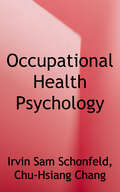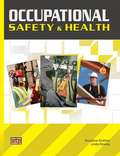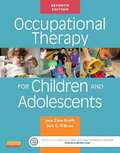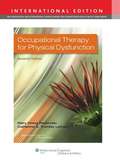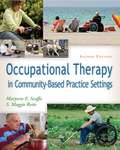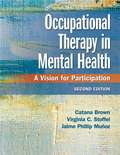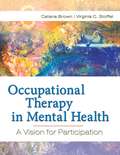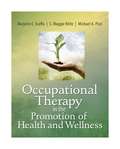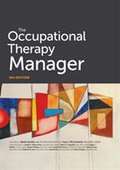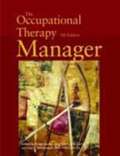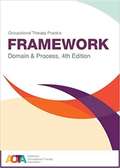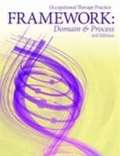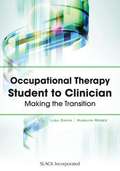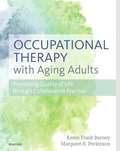- Table View
- List View
Observing Nature
by Lawrence Hall of Science University of California at BerkeleyNIMAC-sourced textbook
The Obsession (Fountas & Pinnell Classroom, Guided Reading)
by Teri Eastman Jan FeindtNIMAC-sourced textbook
The Obstetric Hematology Manual
by Sue Pavord Beverley HuntObstetric hematology is a fast-growing area of medicine covering the diagnosis and management of hematological problems of pregnancy. Comprehensive in approach, The Obstetric Hematology Manual addresses the many hematological conditions that can cause serious problems in pregnancy, delivery and the post-partum period for both mother and baby. Written by a team of international authorities, this text provides up-to-date, evidence-based guidelines on best care, as well as sound advice based on the experience and opinion of experts. Where appropriate, basic principles are discussed to clarify the rationale for management, and systems and procedures for disease prevention are highlighted. Many conditions and cases are discussed, including venous thromboembolism, pre-eclampsia, anemia, thrombocytopenia and inherited disorders. This book will appeal to both trainees and practitioners in obstetrics, obstetric medicine, obstetric anesthesia and hematology. It is also an accessible text for midwives, nurses, and laboratory staff.
Occupation-Based Activity Analysis
by Heather ThomasOccupational therapists use occupations and activities as not just a goal, but also as a treatment medium, therefore, they must understand both the uniqueness of a client’s occupations and how an activity can be used therapeutically. To analyze the complexity of an occupation takes much more depth of understanding of the person engaging in it, his or her environment, and the uniqueness of the occupation a person has chosen. <p><p> The new Second Edition of Occupation-Based Activity Analysis continues the tradition of teaching students and clinicians the process of conducting activity analyses and occupation-based activity analyses. <p> Dr. Heather Thomas has updated Occupation-Based Activity Analysis, Second Edition to reflect the significant changes made to the activity analysis process and terminology in the Occupational Therapy Practice Framework, Third Edition. As in an activity analysis, occupation-based activity analysis looks at what is required for full participation, yet goes beyond analyzing the activity; it looks at what it means for the person engaging in it and how and where it is performed by that person. <p> Inside Occupation-Based Activity Analysis, Second Edition, each chapter is dedicated to a component of the activity analysis process and corresponding section of the Framework. Chapters have been restructured based on a greater emphasis on occupation-based activity analysis. From start to finish, readers are guided through identifying the occupation, sequence and timing, objects and properties, space and social demands, body functions, and structures and performance skills required.
Occupational and Activity Analysis
by Heather ThomasNewly updated to reflect the Occupational Therapy Practice Framework: Domain and Process, Fourth Edition (OTPF-4), Occupational and Activity Analysis, Third Edition outlines the process of conducting occupational and activity analyses for occupational therapy students and clinicians. <p><p>Occupational therapy practitioners use occupations and activities not only as a goal but also as a treatment medium, so understanding both the uniqueness of a client's occupation and how an activity can be used therapeutically is essential. This text is an introduction to both realms, first by explaining the process by which to peel back the layers of an occupation or activity to reveal its intricacy and then examining how to use this information for evaluation and intervention. <p><p>Dr. Heather Thomas has updated Occupational and Activity Analysis, Third Edition to reflect the significant changes made to the activity analysis process and terminology in the OTPF-4. Conducting either an occupational or activity analysis investigates not only what is required for full participation but also looks at the meaning ascribed to it by the people, groups, or communities engaging in it and how personal and environmental contexts impact participation. <p><p> What's new and included in the Third Edition: <p>• Chapters throughout the text have been updated to reflect the changes in the OTPF-4. <p>• Updated educational standards set by the Accreditation Council for Occupational Therapy Education (ACOTE) for doctoral and master's level and occupational therapy assistant programs. <p>• Additional cases and relevant clinical examples. <p>• Updated tables, boxes, and figures throughout. <p>• Expanded section on communication management. <p>• Appendices containing updated occupational and activity analysis forms. <p>• Example of a full activity analysis. <p>• Updated and added photos to help students understand concepts. <p>• Instructors in educational settings can visit www.efacultylounge.com for forms, videos, and PowerPoint presentations to be used for teaching in the classroom. <p><p>As a foundational skill, occupational and activity analysis is utilized throughout students' careers and into their lives as practitioners, making Occupational and Activity Analysis, Third Edition the perfect textbook for the occupational therapy or occupational therapy assistant student, faculty, or clinician.
Occupational, Business and Vocational Technology Education Class 7-Nepal (English Language)
by Nepal Curriculum CenterThis accessible book has been developed by Action on Disability Rights And Development-Nepal (ADRAD) for the free distribution to students with visual and print disabilities in cooperation of Curriculum Development Center and Australian Embassy in Nepal under Direct Aid Program.
Occupational Health Psychology
by Irvin Schonfeld Chu-Hsiang ChangThis comprehensive text for advanced undergraduate and graduate occupational health psychology (OHP) survey courses draws from the domains of psychology, public health, preventive medicine, nursing, industrial engineering, law, and epidemiology to focus on the theory and practice of protecting and promoting the health, well-being, and safety of individuals in the workplace and improving the quality of work life. <p><p>The book will also appeal to anyone who is concerned with the corrosive effects of job stress. The text addresses key psychosocial work issues that are often related to mental and physical health problems, including psychological distress, burnout, depression, accidental injury, obesity, and cardiovascular disease. It examines leadership styles as they impact organizational culture and provides specific recommendations for reducing employee-related stress through improved leader practices. Also addressed is the relationship between adverse psychosocial working conditions and harmful health behaviors, along with interventions aimed at improving the work environment and maximizing effectiveness. Additionally, the book discusses how scientists and practitioners in OHP conduct research and other important concerns such as workplace violence, work and life balance, and safety. The book reinforces learning with key concepts and findings, highlight tables containing intriguing examples of research and current controversies, and chapter summaries.
Occupational Safety And Health
by Rosalene Graham Linda RowleyOccupational Safety & Health provides an overview of potential workplace hazards, necessary safety practices, and how various processes need to be managed in order to maintain a safe workplace. This textbook is designed for use in introductory safety courses and by professionals who want to advance in the field as well as individuals who need to understand and implement safety programs. Appropriate safety regulations and laws, hazard recognition, and personal protective equipment are addressed.
Occupational Therapy For Children And Adolescents
by Jane Case-Smith Jane O'BrienThe sixth edition of Occupational Therapy for Children maintains its focus on children from infancy to adolescence and gives comprehensive coverage of both conditions and treatment techniques in all settings. Inside you'll discover new author contributions, new research and theories, new techniques, and current trends to keep you in step with the changes in pediatric OT practice. This edition provides an even stronger focus on evidence-based practice with the addition of key research notes and explanations of the evidentiary basis for specific interventions.
Occupational Therapy For Physical Dysfunction
by Mary Vining Radomski Catherine A. Trombly LathamSucceed in the course and master the concepts and skills you need to be an effective, reflective practitioner with Occupational Therapy for Physical Dysfunction, 7th Edition. The authors introduce the highly acclaimed, easy-to-understand Occupation Functional Model (OFM) in the first section, setting the stage for subsequent discussions that guide you through the assessment and treatment of adult patients with physical dysfunction from initial evaluation to treatment to follow-up. Featuring engaging and practical coverage, the Seventh Edition includes the latest research in the field, new activity analysis case examples, new photos, new online videos, and a streamlined organization that includes 45 chapters in the print textbook with three additional chapters posted online.tables that highlight the psychometric properties and the strengths and weaknesses of individual assessment methods.
Occupational Therapy in Community-Based Practice Settings (2nd Edition)
by Marjorie E. Scaffa S. Maggie ReitzBe prepared for the growing opportunities to practice in community-based settings with the 2nd Edition of this groundbreaking resource. From basic principles and policy issues through the variety of settings to the future role of the OT, a noted authority in the field introduces you to all aspects of this rapidly expanding field of practice. You'll be prepared to take on new roles, to take unusual risks, and to envision service in creative ways. Reviews of the 1st Edition "This book is highly recommended not only to occupational therapy students and educators but to occupational therapy practitioners as well. For those employed in traditional hospital settings, the abundance of information may certainly help them expand their thinking about the scope of occupational therapy practice. " --Karen Butler Canadian Journal of Occupational Therapy "The text is easily readable and contains chapter key terms and learning objectives which help accentuate information. This text provides a much needed resource for occupational therapists who currently are, or plan to in the future, practice in the community. " --Peggy Wittman, EdD, OTR/L, FAOTA Occupational Therapy in Health Care Journal "Very comprehensive. Reviews a variety of possible settings for community practice and appears to cover the process from the beginning on through. " --Anne Marie Knecht, MA, OTR/L Florida International University, Miami, FL
Occupational Therapy In Mental Health: A Vision For Participation
by Catana Brown Virginia C. Stoffel Jaime MunozUses the Person-Environment-Occupation (PEO) model as a framework to promote the full participation in the lives of individuals with mental illness and those struggling with psychosocial issues related to their disabilities. <p><p> Features first-person “The Lived Experience," narratives that give voice to the experience of living with a mental illness <p> Incorporates “Photo Voice” features, a blend of photography and personal stories that enable individuals to record their visions and experiences to promote dialogue about important issues. <p> Addresses co-occurring conditions such as depression, stroke, substance abuse and spinal cord injury, and attention deficit disorder and learning disabilities. <p> Promotes best practices with “Evidence-Based Practice “boxes that synthesize significant research and implications for practice. <p> Offers extensive information on theory and evidence-based interventions <p> Employs active learning strategies to facilitate the application of knowledge, skills, and attitudes essential for mental health and psychosocial interventions. <p> Addresses occupational therapy in a variety of practice settings for individuals from all cultures across the life span. <p> Discusses non-diagnosis-based populations, such as the homeless, as well as the continuum of care from institution or hospital to the community.
Occupational Therapy In Mental Health: A Vision For Participation
by Catana Brown Virginia C. Stoffel Jaime Phillip MunozThis Client-centered, recovery-oriented text gives voice to the lived experience of mental illness across the life span. You will be guided through the assessment and interventions of individuals with mental health conditions and those whose life circumstances generate significant challenges to their participation in valued activities.
Occupational Therapy in the Promotion of Health and Wellness
by Marjorie E. Scaffa S. Maggie Reitz Michael A. PizziThis book teaches students about health promotion and prevention theory and practice from a wellness rather than an illness perspective. Using "cutting edge" examples, the authors explore how to incorporate this new paradigm into clinical practice and how to develop wellness interventions across the lifespan.
The Occupational Therapy Manager
by Karen Jacobs Guy McCormackIn today s health care, occupational therapy managers and leaders must be prepared to ensure delivery of high-quality care; staff morale and efficiency remain high; businesses and organizations are profitable; and the profession is recognized by other health care professionals, reimbursers, and clients as a valuable service steeped in evidence. The bestselling Occupational Therapy Manager can help occupational therapy practitioners become capable, effective leaders across all practice settings. This new edition includes 76 new chapters in 12 sections that cover leadership and management foundations, organizational planning and culture, navigating change and uncertainty, outcomes and documentation, interprofessional practice and teams, supervision, communication, finance and budgeting, professional standards, ethical and legal considerations, managing your career, and public policy. Each chapter includes learning objectives, key terms, essential considerations and practical applications in occupational therapy, a case example, and relevant ACOTE Standards. The most comprehensive management book in the profession, this is a fundamental, classic text for all occupational therapy students, practitioners, and managers.
Occupational Therapy Manager (Fifth Edition)
by Karen Jacobs Guy L. MccormackIn today's health care environment, occupational therapy practitioners in clinical and leadership positions must be prepared to ensure that clients receive the highest quality of care; staff morale and efficiency remain high; businesses and organizations are profitable; and the profession is recognized by other health care professionals, reimbursers, and clients as a valuable service steeped in evidence. The Occupational Therapy Manager, 5th Edition can help occupational therapy practitioners become capable, effective leaders across all practice settings. This new edition includes 37 new and updated chapters, discussing the how-to aspects of creating evidence-based practices; effectively leading and motivating staff; ensuring ethical service delivery; and important day-to-day items such as budgeting, documentation, and reimbursement. Chapters also are updated to reflect health care reform and its potential effects on occupational therapy. Highlights Include-- *Section I: Defining and Rethinking Management *Section II: Strategic Planning *Section III: Leading and Organizing *Section IV: Controlling Outcomes *Section V: Public Policy, Professional Standards, and Collaboration *Section VI: Supervision *Appendixes--Occupational Therapy Code of Ethics and Ethics Standards, Scope of Practice, and more The Occupational Therapy Manager is the best-selling and most comprehensive management book in the profession and is a fundamental, classic text for all occupational therapy students, practitioners, and managers.
Occupational Therapy Practice Framework: Domain & Process
by American Occupational Therapy AssociationThe Occupational Therapy Practice Framework: Domain and Process (OTPF) summarizes the interrelated constructs that describe occupational therapy practice. It is intended for a wide audience of occupational therapy practitioners and students, other health care professionals, educators, researchers, payers, and consumers. This 4th edition (the OTPF 4) continues its predecessors mission to provide structure and guidance for practitioners to achieve the distinct value of occupational therapy in the clinic and other settings. An American Occupational Therapy Association (AOTA) official document, the OTPF is reviewed on a 5-year cycle. The review period includes the voices of AOTA members, scholars, authors, practitioners, AOTA volunteer leadership and staff, and other stakeholders to ensure that the document maintains its integrity while responding to emerging concepts and advances in occupational therapy. The OTPF 4 includes the following changes: *Increased focus on group and population clients *Identification of the cornerstones of occupational therapy practice, foundational to the success of occupational therapy practitioners *More explicit description and definition of the terms occupational science, occupation, and activity *Changes in terminology to accord with the taxonomy from the World Health Organization s International Classification of Functioning, Disability and Health (ICF) *Inclusion of gender identity as a client factor under experience of self and time *Discussion of transitions and discontinuation as outcomes to occupational therapy services *Discussion of patient-reported outcomes *Five new tables to expand on and clarify concepts. The OTPF 4 represents the latest articulation of the occupational therapy domain and process, building on a set of values that the profession has held since its founding in 1917. Embedded in this document is the occupational therapy profession s core belief in the positive relationship between occupation and health and its view of people as occupational beings.
Occupational Therapy Practice Framework: Domain and Process
by American Occupational Therapy Association StaffAs occupational therapy celebrates its centennial in 2017, attention returns to the profession's founding belief in the value of therapeutic occupations as a way to remediate illness and maintain health. The founders emphasized the importance of establishing a therapeutic relationship with each client and designing an intervention plan based on the knowledge about a client's context and environment, values, goals, and needs. Using today's lexicon, the profession's founders proposed a vision for the profession that was occupation based, client centered, and evidence based--the vision articulated in the third edition of the Occupational Therapy Practice Framework: Domain and Process. <P><P>The Framework is a must-have official document from the American Occupational Therapy Association. Intended for occupational therapy practitioners and students, other health care professionals, educators, researchers, payers, and consumers, the Framework summarizes the interrelated constructs that describe occupational therapy practice. In addition to the creation of a new preface to set the tone for the work, this new edition includes the following highlights: a redefinition of the overarching statement describing occupational therapy's domain; a new definition of clients that includes persons, groups, and populations; further delineation of the profession's relationship to organizations; inclusion of activity demands as part of the process; and even more up-to-date analysis and guidance for today's occupational therapy practitioners. <P><P>Achieving health, well-being, and participation in life through engagement in occupation is the overarching statement that describes the domain and process of occupational therapy in the fullest sense. The Framework can provide the structure and guidance that practitioners can use to meet this important goal.
Occupational Therapy Student to Clinician: Making the Transition
by Lisa Davis Marilyn RoseeIt is an imperative need and a great challenge to support the professional development of competent OTs. The complexity of demands in the workforce exceeds the requisite of clinical knowledge and reasoning.
Occupational Therapy With Aging Adults: Promoting Quality Of Life Through Collaborative Practice
by Karen Barney Margaret PerkinsonLook no further for the book that provides the information essential for successful practice in the rapidly growing field of gerontological occupational therapy! Occupational Therapy with Aging Adults is a new, comprehensive text edited by OT and gerontological experts Karen Frank Barney and Margaret Perkinson that takes a unique interdisciplinary and collaborative approach in covering every major aspects of geriatric gerontological occupational therapy practice. With 30 chapters written by 70 eminent leaders in gerontology and OT, this book covers the entire continuum of care for the aging population along with special considerations for this rapidly growing demographic. This innovative text also covers topical issues spanning the areas of ethical approaches to treatment; nutrition and oral health concerns; pharmacological issues; low vision interventions; assistive technology supports; and more to ensure readers are well versed in every aspect of this key practice area.
Ocean, Atmosphere, and Climate: Cold Years in New Zealand, Investigation Notebook with Article Compilation
by The Lawrence Hall of ScienceNIMAC-sourced textbook
